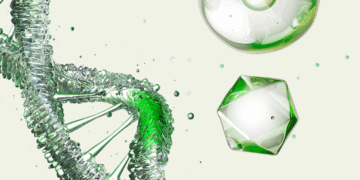Advances in the biology, biotechnology, and pharmaceutical industries have complicated the criteria for eligible patents. Are living organisms patentable? Are assays that measure naturally occurring molecules or isolated DNA fragments considered inventions? How different does a cDNA molecule need to be from the naturally occurring sequence to be patent-eligible?
Determining patentability for inventions in genetics and genomics is particularly challenging because these innovations often involve naturally occurring organisms and cells. Naturally occurring genetic material and organisms are not “invented,” but many argue that identifying the applicability of genes and organisms and developing methods to isolate them requires intellectual ingenuity and deserves intellectual and financial reward. For example, a test that detects a genetic mutation associated with cancer could identify individuals who would benefit from frequent screening for early detection of the disease. On that basis, jurisdictions in Australia, Japan, Canada, and the European Union have accepted many of these innovations as patentable. However, U.S. Supreme Court decisions Mayo v Prometheus (2012) and Molecular Pathology v Myriad Genetics, Inc. (2014) have substantially restricted the patentability of tests or methods that detect or isolate naturally occurring products (such as metabolites and genomic DNA sequence fragments) in this country, regardless of the novelty or utility of the method used to create the product.
Some experts suggest that removing patentability of genes and naturally occurring metabolites improves accessibility of information and testing to other researchers, providers, and patients. Others argue the new U.S. legislation denying gene patents puts the country’s biotechnology research at a competitive disadvantage with the rest of the world and fails to acknowledge a key strength of biotechnology: the ability to improve availability of resources, diagnosis and treatment of human disease, and patient lifestyle by utilizing existing DNA information. Most agree that guidelines for patenting these innovations must strike a balance between encouraging innovation and optimizing accessibility for other researchers to build on the knowledge and individuals to benefit from the inventions.
A Turning Point for Biotechnology Research, Followed by Some Roadblocks
Diamond v Chakrabarty (1980) was a landmark case for biotechnology research and opened the door for scientists to investigate the utility of living organisms for diagnostic and therapeutic purposes. In this case, genetic engineer Ananda Mohan Chakrabarty had attempted to patent a genetically modified bacterium that could break down multiple components of crude oil. Although the bacterium he developed had unique characteristics not found in naturally occurring bacteria, his bid for a patent was initially rejected because living organisms were generally accepted as unpatentable. Ultimately, the U.S. Supreme Court sided with Chakrabarty and stated that living organisms were patentable as long as they were manmade, and the fact that they were living was irrelevant to patentability.
The Chakrabarty decision helped assure biotechnology companies and investors that the U.S. patent system would protect modifications of naturally occurring subject matter and has encouraged development of breakthrough medical therapies, improvements in crop yields, and creation of renewable fuels (Quinn 2010). Researchers have obtained patents for naturally occurring antibiotics and therapeutically useful toxins, as well as for methods to isolate nucleic acids, peptides, and proteins — all of which has improved diagnosis of disease and personalization of treatment. However, two recent Supreme Court decisions, Mayo v. Prometheus (2012) and Association for Molecular Pathology v Myriad Genetics, Inc. (2013), have threatened to discourage the incentive to file for patent claims on biotechnology innovations.
In the Mayo v Prometheus (2012) case, Mayo Collaborative Services attempted to patent methods that determined the optimal dose of thiopurine to use for patients with inflammatory bowel disease based on blood levels of 6‑thioguanine, a naturally occurring metabolite, in a diagnostic assay developed by Prometheus Laboratories. Prometheus argued that Mayo’s work infringed on their already established patent for the assay and after four years of legal battles, the U.S. Supreme Court determined that the inventive concept for assessing the relationship between naturally produced metabolites (6-thioguanine) and the therapeutic efficacy and toxicity of a drug (thiopurine) could not be patented because the methods were setting forth a “law of nature” (that is, the body’s natural interaction with a compound), which is not a manmade entity.
Association for Molecular Pathology v Myriad Genetics, Inc. (2013) is another controversial case, and the decision against Myriad has limited patentability of isolated, naturally occurring DNA sequences. The diagnostic testing company isolated, sequenced, and patented the BRCA1 and BRCA2 genes and used these sequences to develop a test for BRCA gene mutations that are strongly associated with breast and ovarian cancer. Myriad also obtained patents that covered the process of isolating the wild-type and mutant genes and creating the cDNA. Unlike many other patent holders that license specific patent rights to others for a fee, Myriad refused to license the test to other laboratories and threatened to sue those that offered BRCA testing. The American Civil Liberties Union filed a lawsuit against Myriad on behalf of the Association for Molecular Pathology, claiming that isolated DNA is not patentable because it is a naturally occurring substance. The Supreme Court eventually decided that isolated DNA sequences were not patentable if they shared identical informational content with sequences that occur in nature, even though Myriad argued that the process of severing chemical bonds to isolate DNA creates a non-natural molecule. The Court also specified that “long” cDNAs (spanning two or more exons) are patentable because removing the introns requires a human-driven process, but single-exon cDNAs are not because they have the same sequence as that exon in naturally occurring DNAs. Although the impact of these court cases has yet to be fully realized, the Mayo decision has already led the U.S. Court of Appeals to invalidate a patent for Sequenom’s noninvasive prenatal test for Down syndrome because it detects naturally occurring DNA, strongly suggesting that the decisions could render many gene-related products ineligible for patent.
Consequences of the Myriad and Mayo Cases
Amending Patent Claims and Developing Trade Secrets
Proponents of gene patents claim that this protection of intellectual property incentivizes development of and investment in clinically relevant advances. Patent attorneys indicate these new rulings could negatively affect the business models for companies that develop such tests and result in fewer diagnostic tests coming to market. “Getting a patent that claims a natural product or includes a natural process will now be more difficult,” said John Iwanicki, a patent attorney at Banner & Witcoff in Boston. “Applicants will probably amend their claims to comply with the guidelines, which could mean that the scope of the invention will shrink” (Harrison 2014). Even the three judges that were involved in the Sequenom case stated that the test in question has a positive and valuable contribution to science and expressed concern that the current interpretation of the Mayo decision could discourage development and disclosure of novel diagnostic and therapeutic methods. Brian Dorn, a Minneapolis-based attorney specializing in patent law, stated in a viewpoint letter in ACS Medicinal Chemistry that the Mayo decision means that an innovation that identifies a unique biological relationship, often the foundation for new clinical diagnostic methods, can be patented only if the testing methods are novel (Dorn 2013). Dorn predicted that inventors would likely revise their new applications to avoid using “law of nature” as a central part of their patent claim.
However, previous studies suggest that patents are not the primary drivers of innovation (Holman 2008) and that limitations on gene patenting could cause innovators to protect their developments as trade secrets instead of a patent (Merz and Cho 2005). This could ultimately limit the scope of the research because trade secrets do not require public disclosure and do not expire the way patents do. Even if patents expire or are declared invalid, trade secrets (such as Myriad’s proprietary database of BRCA variants of unknown significance) may restrict access to information necessary for competitors to build on the information and for physicians to make clinical interpretations.
U.S. vs. the World: Increased Patent Discord May Put U.S. Biotechnology at a Disadvantage
According to some experts, the increasing restrictions on patentability of biotechnology innovations may also deplete the U.S.-based pool of research as scientists pursue gene patents in other countries. In D’Arcy v Myriad Genetics Inc. (2014), the full Federal Court of Australia initially contradicted the U.S. Supreme Court decision by supporting Myriad’s patent claims to the isolated DNA and explicitly stating that the chemical changes in the isolated nucleic acid make it a chemically distinct, economically useful entity that is eligible for patent. However, the Federal Court later overturned this decision in October 2015 and revoked Myriad’s patent, stating that the isolated DNA did not qualify as a “manner of manufacture” defined by Section 18(1)(a) of the Patents Act 1990 (Cth). Although isolating the DNA was a product of human labor, the information stored in the DNA — the essential element of Myriad’s invention — is identical to the information contained in the DNA of a person and is thus not manufactured, according to the Federal Court.
Irena Royzman, a patent lawyer specializing in biotechnology, agreed that the U.S. Supreme Court’s sole focus on the informational content of DNA, rather than its utility in identifying mutations, is misguided. She specified that the somewhat arbitrary declaration of multiple-exon but not single-exon cDNA as patentable, even though both items are synthetically created, indicates their lack of scientific understanding (Royzman 2015). Furthermore, Sequenom representatives believe that an appeal to the Supreme Court, which they are currently looking into, will be successful because Europe, Japan, Hong Kong, Canada, and Australia have implemented valid, enforceable patents with claims similar to those of the patent in question and the U.S. will feel pressured to align its guidelines with other countries’.
If drastic discrepancies in judicial decisions among countries persist, substantial differences in competitors’ access to information could result. The difference in patent regulations between the U.S. and Europe has led to substantially different claims for the controversial CRISPR-Cas9 patent in the respective regions, which may affect other researchers’ rights to use the technology (Kupecz 2014). Royzman stated that overall, the Supreme Court’s failure to acknowledge the fundamental strength of biotechnology — the application of informational content in DNA to therapeutic and diagnostic purposes — will put the U.S. industry at a significant disadvantage unless the U.S. changes its laws to encourage better patent harmonization with other countries (Royzman 2015).
Nonexclusive Licensing of Patents: Benefitting Innovators, Competitors, Providers, and Patients
Opponents of gene patenting state that obtaining exclusive rights for or imposing license or royalty fees to work with a patented gene could discourage or prevent market entry by other companies and possibly interfere with development of more effective tests and availability of second-opinion testing. For example, some experts believe Myriad’s proprietary database of BRCA mutations and its claiming of exclusive rights to the mutations may have hampered discovery of clinically relevant gene mutations by preventing clinicians and researchers from identifying and characterizing previously unknown BRCA missense variants (McElligott 2012). However, no independent studies confirm that Myriad’s BRCA patent impeded basic science research, and studies suggest that (unlike Myriad) most gene patent holders do not aggressively enforce patent rights or refuse to grant licenses that permit others to study the gene (Merz and Cho 2005).
In fact, one analysis indicated that the broad, nonexclusive licensing practices for cystic fibrosis gene mutations have promoted innovation while enabling competition among researchers and increasing availability of cost-effective testing to patients (Chandrasekharan 2010). The University of Michigan, Johns Hopkins University, and the Hospital for Sick Children in Toronto, Ontario granted nonexclusive licenses (which allow multiple licensees to access a patented innovation) for diagnostic use, gene transfer, and other therapeutic applications of their patented genetic sequences, mutations, and detection methods for cystic fibrosis because they were concerned that exclusive licensing would limit access to select groups and compromise the scope of long-term research and development of diagnostic methods. Since the initial patents were granted in 1989 for the normal and ΔF508-mutant CFTR cDNAs sequences, genetic testing, normal and mutant CFTR proteins, and vectors and cell lines expressing normal and mutant CFTR genes, more than 1,000 different mutations in the CFTR gene have been identified and research continues to determine the significance of the mutations. According to interviews with researchers and intellectual property managers, the patent process and nonexclusive licensing did not slow or disincentivize the research leading to discovery of the gene; restrict test development or adoption of tests by laboratories, healthcare providers, or third-party payers; or reduce patient access to tests.
Overall, the authors suggested that the cooperative and collaborative model used by researchers and clinicians that included nonexclusive licensing to multiple researchers facilitates a healthy environment of innovative research and cost-effective clinical testing while preserving patent protection, which may be particularly beneficial with the rapid development of genetic and biotechnology research. Many experts agree that creating legislation that promotes innovation and healthy competition may ultimately lead to greater scientific advances as a whole and better personalized solutions for patient diagnosis and treatment.
How do you think we should approach patenting biotechnology innovations? Post your comments below!
References
Association for Molecular Pathology v Myriad Genetics, Inc. 569 United States __, 133 S. Ct. 2107, 106 USPQ2d 1972 (2013).
Chandrasekharan S et al. (2010). Impact of Gene Patents and Licensing Practices on Access to Genetic Testing for Cystic Fibrosis. Genet Med. 12, S194–S211.
D’Arcy v Myriad Genetics Inc. (2014) FCAFC 115.
D’Arcy v Myriad Genetics Inc & Anor [2015] HCA 35 austlii.edu.au/cgi-bin/sinodisp/au/cases/cth/HCA/2015/35.html
Diamond v Chakrabarty, 447 United States 303, 206 USPQ 193 (1980).
Dorn (2013). Mayo v. Prometheus: A Year Later. ACS Medicinal Chemistry Letters 4, 572–573.
Harrison C (2014). Patenting natural products just got harder. Nat Biotechnol 32, 403–404
Holman (2008). Trends in Human Gene Patent Litigation. Science 322, 198–199.
Kupecz (2014). Who owns CRISPR-Cas9 in Europe? Nat Biotechnol 32, 1194–1196.
Mayo Collaborative Servs. v Prometheus Labs., Inc. 566 United States __, 132 S. Ct. 1289, 101 USPQ2d 1961 (2012).
McElligott S et al. (2012). How genetic variant libraries effectively extend gene testing patents: Implications for intellectual property and good clinical care. J Clin Oncol 30: 2943-2945.
Merz JF and Cho MK. (2005). What are gene patents and why are people worried about them? Community Genet 8, 203–208.
Patents Act (1990) (Cth) legislation.gov.au/Details/C2016C00344
Quinn G (2010). June 16, 2010: 30th Anniversary of Diamond v. Chakrabarty. ipwatchdog.com/2010/06/16/june-16-2010-30th-anniversary-of-diamond-v-chakrabarty/id=11268/, accessed March 25, 2016.
Royzman I (2015). Biotechnology patents under fire. Nat Biotechnol 33, 923–924.
Resources
Elliott G (2007). Basics of US patents and the patent system. AAPS J 9, E317–E324.
Kutscher B (2012). AMA backs invalidation of Prometheus patents. Modern Healthcare, March 21, 2012. modernhealthcare.com/article/20120321/MODERNPHYSICIAN/303219990, accessed November 2, 2015.
Philippidis A (2015). Appeals Court Upholds Invalidity of Sequenom Patent. Genetic Engineering & Biotechnology News, June 15. www.genengnews.com/keywordsandtools/print/4/38613/, accessed Nov. 2, 2015.
PR Newswire. Sequenom Comments On U.S. Court Of Appeals For The Federal Circuit Decision On ‘540 Patent. prnewswire.com/news-releases/sequenom-comments-on-us-court-of-appeals-for-the-federal-circuit-decision-on-540-patent-300187298.html, accessed March 25, 2016.
USPTO (2014). Guidance for Determining Subject Matter Eligibility of Claims Reciting or Involving Laws of Nature, Natural Phenomena, & Natural Products. uspto.gov/patents/announce/myriad-mayo.jsp, accessed November 2, 2015.
Watson J. United States Court of Appeals for the Federal Circuit 2010–1406, patentdocs.typepad.com/files/watson-amicus-brief.pdf, accessed October 28, 2015.
United States Patent and Trademark Office. General Information Concerning Patents. uspto.gov/patents-getting-started/general-information-concerning-patents, accessed April 20, 2016.



